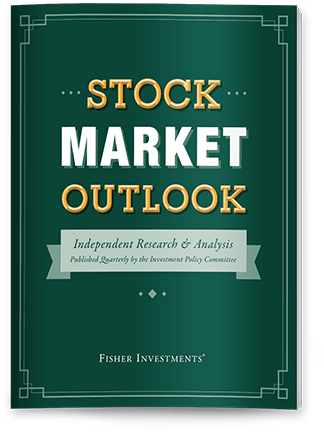Save for Retirement: When, Where and How
You are not alone if you’re feeling overwhelmed when sorting through endless advice about saving for retirement. At Fisher Investments, we believe that successful retirement outcomes can be less about the specific financial securities you pick and more about approaching the retirement-planning process efficiently. That means examining when, where and how you save for retirement.
When to Start Saving: Earlier is Almost Always Better
One of the biggest risks individuals face is starting to invest for retirement too late. Delaying your planning and investing can limit your ability to reach your long-term investment goals or increase your chances of running out of money in retirement.
You can help guard against these possibilities by planning and starting your retirement saving early. This can help allow more time for investment returns to compound and increase your retirement income potential. Compounding occurs as investment returns, including capital gains and income, are reinvested to create additional earnings over time.
To understand this process, consider the following example. Imagine you are 30 years old and invest $5,000 every year for 10 years, but then stop contributing at age 40. At the S&P 500's historical average annual return of approximately 10%, you will have accrued more than $1.1 million by the time you reach a typical retirement at age 65.1

Where Might the Market Go Next?
Confidently tackle the market’s ups and downs with independent research and analysis that tells you where we think stocks are headed—and why.
Compare this scenario to that of someone who begins saving at 40. By putting away the same $5,000 each year until age 65with the same rate of return, they would accrue more than $600,000. The person who waited until 40 to start saving will have put in $80,000 more, yet, when they retire, realizes $500,000 less. This makes it clear: the earlier you start saving, the more your money is likely to work for you.
Another advantage to investing for retirement early is a greater ability to withstand market volatility. In the prior example, we assumed an average S&P 500 return of about 10%. In reality, however, market movements can be far above or below this in any year. For example, since 2000, the S&P 500 has seen annual returns of as high as 32% in 2013 and losses as low as -37% in 2008.2 As the average annual return of around 10% suggests, though, the gains more than make up for the losses over the long term.
Where to Save: IRAs, 401(k)s and More
Once you’ve decided to start saving, it’s important to consider where to put your money. While there are numerous types of retirement savings accounts, traditional individual retirement accounts (IRAs) and defined contribution plans are by far the most popular.
401(k)s
401(k) plans are employer-sponsored, defined contribution accounts that allow employees to invest through automatic paycheck deductions. In many instances, your employer will either add to or match your contributions, regardless of market performance. With a standard 401(k), contributions are taken from your check before income taxes are calculated. Furthermore, gains on the money in the account are not taxed by the IRS initially. Instead, the tax is deferred and paid at your ordinary income tax rate when your withdraw the money. In most cases, however, you could face penalties for withdrawing before age 55.
IRAs
Traditional IRAs also offer tax-deferred growth on investments. However, most IRA accounts aren’t associated with an employer. IRAs operate like any other brokerage account, except there may be penalties for withdrawals before age 59½. Since traditional IRAs don’t generally receive employer contributions, there are usually no instant returns for contributions. Instead, IRAs offer investors more flexibility when contributing to their retirement income.
Roth-type accounts
In addition to standard types of IRA and 401(k) accounts, you’ll also likely find “Roth” varieties (Roth IRAs and Roth 401(k)s). Roth accounts allow your investments to grow tax-free like their traditional counterparts, but contributions come from after-tax income. Because of this, the withdrawals from these accounts (whether principal or gains) aren’t taxed again so long as the money has been held for at least 5 years. This makes them ideal for investors who expect their income tax burden to increase later in life.
Roth-type retirement accounts have some additional restrictions. For example, single tax filers must have a modified adjusted gross annual income of less than $129,000 to make contributions to a Roth IRA.3 Moreover, Roth 401(k)s cannot have employer matches. It’s also important to note that annual limits count contributions to any account of that type. So if you’re already contributing the maximum to a standard IRA or 401(k), you won’t be able to also contribute to a Roth IRA or Roth 401(k), respectively.
How to Save: Passive versus Active
Once you’ve looked at when and where to save, it’s finally time to start addressing “how.” The concept of passive investing has gained popularity with retirement savers over the years. The concept is simple: Invest in a fund tied to an index that shows long-term growth and keep it there as long as possible.
While proponents tout passive investing as the best way to achieve consistent, long-term growth, the strategy has a hidden weakness. In an ideal world, the passive investor would invest in an index fund—such as an exchange-traded fund (ETF) or mutual fund—and let their portfolio sit untouched for decades. However, media scaremongering and perceptions of volatile markets tap into our brains’ natural tendency to avoid risk or loss. This idea of “loss aversion” makes it very difficult for investors to stay calm and hold steady.
Active managers, alternatively, get results by helping investors better judge when action is needed. A wise investment manager can help an investor stay disciplined when short-term gains and fear of loss. Moreover, when given discretionary authority to trade on your behalf, an experienced professional investment manager can help identify trouble and potentially shift your account when truly warranted. The decision between active or passive investing ultimately comes down to your goals and personal discipline.
Retirement Planning Risks: It’s All about Trade-Offs
There is no such thing as the “perfectly safe” retirement plan; all decisions involve some trade-off between risk and reward.
Every investment—whether it's a mutual fund, real estate, or cash—has an element of risk. Stocks might exhibit volatility in the short-term, but this tendency belies their true benefit to investors. While it’s true that stocks are historically prone to short-term corrections and periods of loss, they also have a history of achieving the highest longer-term returns of any similarly liquid investment.4
By way of comparison, many investors consider bonds to be a relatively “safe” investment. Bonds come with stronger guarantees for investors. Their value tends to move more predictably in relation to interest rates. Despite this, bonds are still subject to market risk and issuer defaults. What is important here, however, is evaluating these various types of investments with respect to your goals and investment time horizon.5
Whatever you choose to do, early action can help mitigate risk; the sooner you start planning and saving for your retirement, the better.
1 Source: FactSet Global Financial Data, as of 8/23/2022. Based on 10.35% annualized S&P 500 Index total returns from 1926-2021
2 IBID
3 Source: IRS 2022 Roth IRA contributions limits Amount of Roth IRA Contributions That You Can Make for 2022 | Internal Revenue Service (irs.gov)
4 Source: FactSet Global Financial Data, as of 02/18/2022. Since 1926, stocks have posted annualized returns of 10.3%, outperforming corporate bonds, gold, US Treasurys and municipal bonds.
5 As of June 30, 2022




